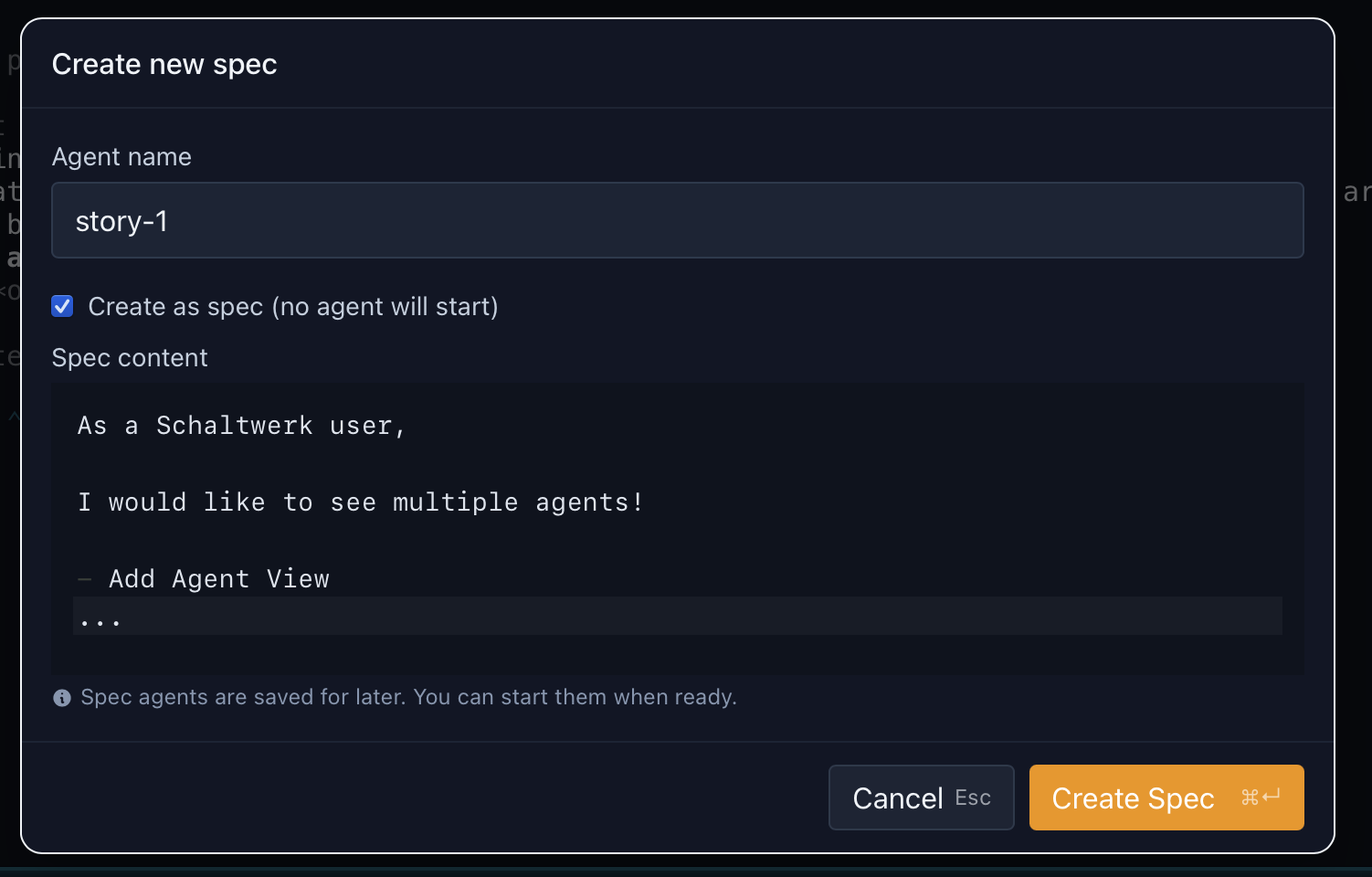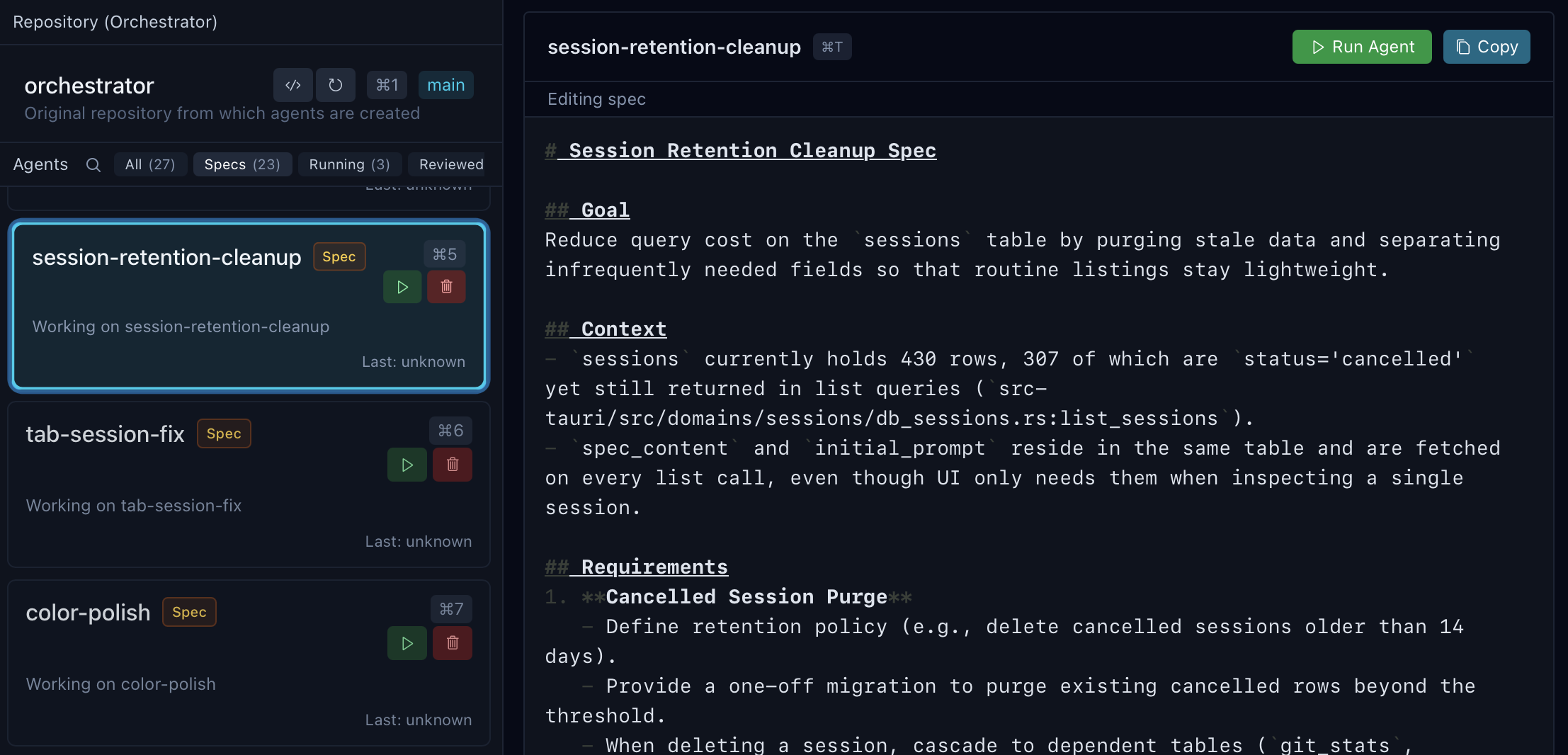Core Principles
One Session Per Feature
Create a dedicated session for each feature or bugfix. Keep work isolated and manageable.
Review Before Merge
Always review changes with
⌘G and test before merging. Agents make mistakes.Clean Up After Merge
Cancel sessions with
⌘D after successful merge to keep your workspace tidy.Use the Orchestrator
Plan and coordinate work in the orchestrator (
⌘1) before creating sessions.Recommended Workflow
1. Plan in the Orchestrator
Press⌘1 to switch to the orchestrator—a special session that stays on your main branch.
1
Create a spec
Press
⌘⇧N to create a planning document:- Break down the feature into tasks
- List requirements and constraints
-
Document the architecture

2
Ask the orchestrator
Use the orchestrator’s agent terminal to:
- Get implementation suggestions
- Generate task breakdowns
- Plan the overall approach
3
Convert to sessions
Once you have a plan, create individual sessions for each task

2. Create Sessions
For each feature or task:1
Press ⌘N
Open the New Session dialog
2
Name it descriptively
Use names like:
feature-authnotsession1fix-typescript-errorsnotfixesrefactor-api-layernotrefactor
3
Write a clear prompt
Be specific about what you want:Good:
“Add JWT-based authentication with login, logout, and token refresh endpoints. Use bcrypt for password hashing.”Bad:
“Add auth”
4
Select the right agent
- Complex refactoring? Use Claude Code
- Quick fixes? Use Codex
- Experimenting? Try different agents
3. Monitor Progress
- Agent Terminal (⌘T)
- Your Shell (⌘/)
- Run Mode (⌘E)
Watch the agent work in real-time:
- See which files it’s reading
- Understand its reasoning
- Spot issues early
4. Review Changes
Before marking as reviewed:1
Open the diff (⌘G)
Review every change the agent made:
- Check for unintended modifications
- Look for commented-out code
- Verify no secrets were added
2
Run tests
In the bottom terminal or with
⌘E:Swapbunfornpmif you’re using npm scripts.
3
Test manually
Actually use the feature:
- Start the dev server
- Test the happy path
- Try edge cases
- Check error handling
5. Mark as Reviewed
When you’re confident:1
Press ⌘R
Marks the session as reviewed
2
Session moves to Reviewed filter
Use
⌘←/→ to switch between All/Specs/Running/Reviewed6. Merge or PR
- Solo Developer
- Team Environment
Press
⌘⇧M to merge directly to main:- Fast and simple
- No PR overhead
- Good for personal projects
Make sure you reviewed and tested first!
7. Clean Up
After successful merge:1
Press ⌘D
Cancel the session and remove the worktree
2
Confirm deletion
Schaltwerk asks for confirmation to prevent accidents
3
Worktree is removed
The isolated git worktree and branch are deleted
Want orchestration playbooks and multi-agent patterns? Jump to the Advanced Workflows guide.
Navigation Tips
Quick Session Switching
Quick Session Switching
⌘1- Orchestrator⌘2-9- Sessions 1-8⌘↑/↓- Cycle through sessions in current filter
Filter Views
Filter Views
⌘←/→- Switch between All/Specs/Running/Reviewed- See exactly what you need when you need it
Multi-Project Workflows
Multi-Project Workflows
⌘⇧←/→- Switch between project tabs- Perfect for frontend ↔ backend workflows
- See the multi-project guide for full tips
Terminal Focus
Terminal Focus
⌘T- Focus agent terminal⌘/- Focus your shell⌘E- Run configured script
Common Patterns
Feature Development
Bug Fix
Refactoring
Things to Avoid
Don’t:
- Merge without reviewing (
⌘Gfirst!) - Cancel sessions before merging (use
⌘Sto recycle the spec—this deletes the session worktree/branch and loses uncommitted changes) - Create vague prompts like “fix it”
- Forget to run tests before marking reviewed
- Let sessions pile up—clean up after merging
- Work directly in the orchestrator for features (create sessions instead)

